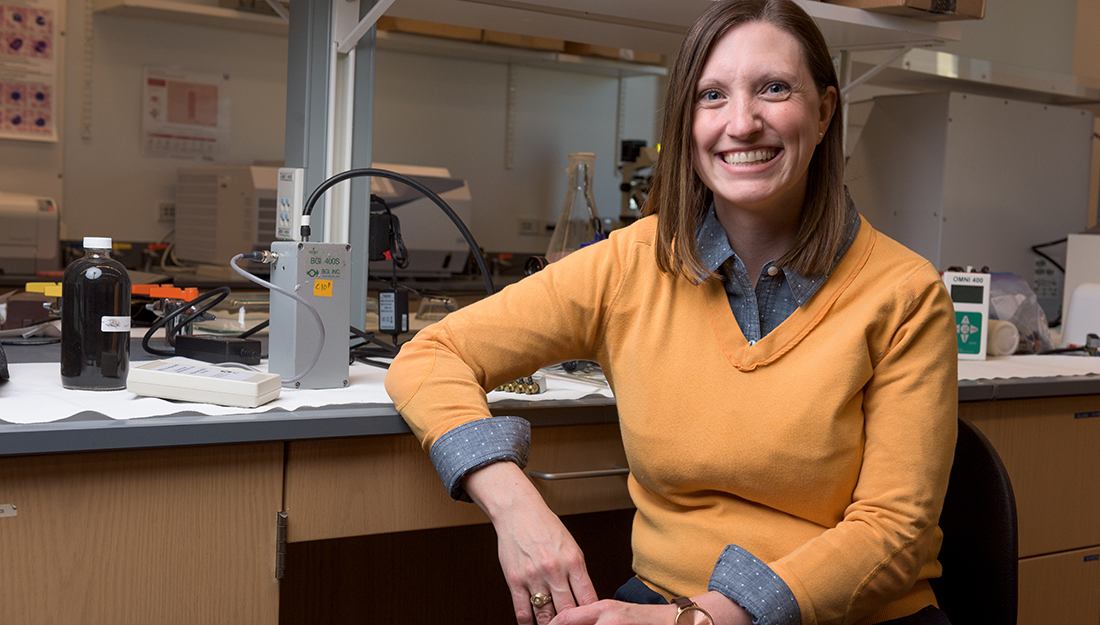- Christina Sumners
- Public Health, Research, Show on VR homepage
Tracking pollution exposure and its health effects
How the chemicals mothers breathe affect their children

iTexas A&M University Health Science Center
Each person, every day, is exposed to environmental contaminants with the potential to cause damaging health effects. If a woman is pregnant, the potential consequences are more serious, possibly affecting her baby for the rest of their life.
That’s why Natalie Johnson, PhD, assistant professor at Texas A&M School of Public Health, is studying pregnant women’s exposure to contaminants in the air, especially in South Texas, using both laboratory and applied research.
“I wear two hats,” Johnson said. “There’s the mechanistic toxicology work in the lab, and more applied epidemiology in the field. One side does the modeling, the other does the monitoring.”
That monitoring is done with backpack-styled air sampling equipment, which she has given out to pregnant women in McAllen, Texas, and asked them to wear for three separate 24-hour periods. These backpacks measure levels and types of air pollutant exposure.
“We’re especially interested in the very small particulate matter that can penetrate the lungs deeply and cause oxidative stress,” Johnson said. Oxidative stress can cause tissue damage and potentially harm to fetal development. When the contaminants are able to cross the placenta to the developing fetus, the problems can be even greater, potentially lowering birth weight, causing premature birth and perhaps leading to increased risk of developing asthma later in life.
Johnson said she hopes to eventually sample the air more conveniently, with simple silicone bracelets instead of bulky backpacks. Right now, she is having people wear both, and then she and her team compare the results to see if they match.
Johnson chose McAllen because of its high asthma rates. “When I began working with Genny Carrillo, who studies asthma in South Texas, I wondered if there was an underlying reason for these higher rates in the environment,” Johnson said. In addition to measuring the levels of particulate matter mothers are exposed to, she and her team will study the levels of chemicals that women’s bodies absorb by testing urine samples.
In addition to her work in McAllen, Johnson is examining benzene exposure of women in Houston who delivered their babies in the months after Hurricane Harvey. It’s known that benzene is a risk factor for childhood leukemia. “This is an opportunity to measure individual exposure to benzene in sensitive populations, like pregnant women,” she said.
Johnson also works in the lab with animal models to shed light on the mechanism behind susceptibility to respiratory disease following prenatal exposures. She found that when animal models were challenged with allergens like dust mites, those exposed to pollutants before they were born weren’t able to mount as robust an immune response. This may represent a window of susceptibility to respiratory infections. Now, she and her team are trying to determine which subsets of immune cells are driving these changes and how this relates to maternal oxidative stress so they can potentially derive a way to counteract the effects.
To carry out this work, Johnson recently received the Outstanding New Environmental Scientist (ONES) award from National Institute of Environmental Health Sciences (NIEHS), a center of the National Institutes of Health (NIH), for her research on infant respiratory disease. The award, worth just over $2 million, is for a multiyear project on the mechanisms of particulate matter-driven infant respiratory disease. She is currently studying how prenatal exposure to air pollution may cause an increased risk of infant respiratory infection due to respiratory syncytial virus (RSV). RSV is a major cause of infant hospitalization in the United States.
“My main goal is for research findings to influence policy or inform interventions for exposed populations,” Johnson said. “I’m a mom, and I remember when I was pregnant with my children, so this work is very personal to me. If we could protect women and their babies then that is a chance to make a huge public health impact.”
Media contact: media@tamu.edu


